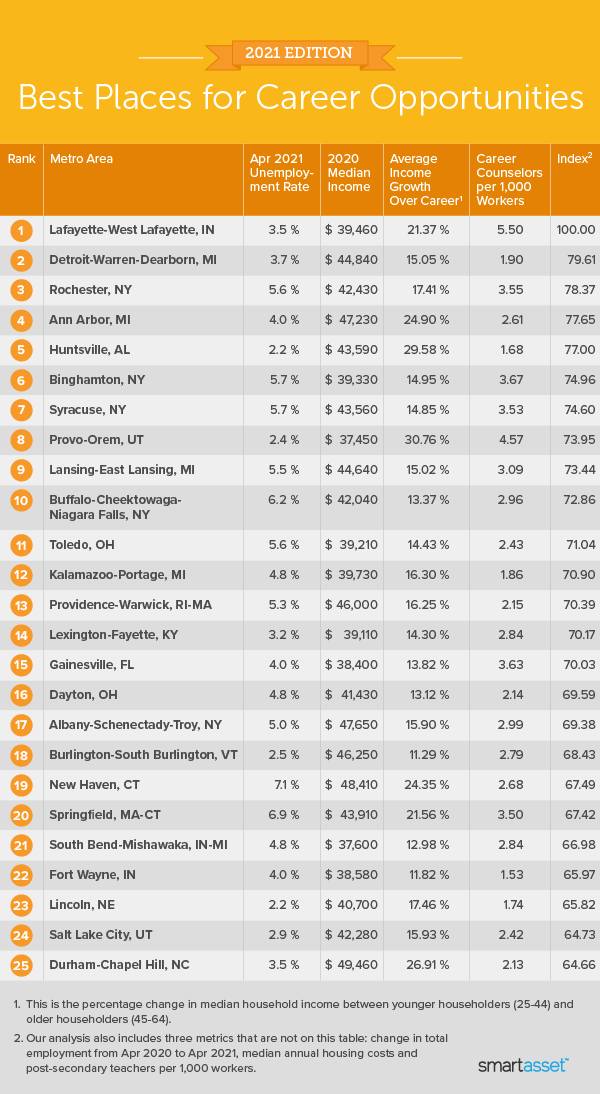According to the Bureau of Labor Statistics, more than six million people reported not working at all or working fewer hours in June 2021 because their employer closed or lost business due to the pandemic. While the record high unemployment rate of 14.7% in April 2020 compelled many to budget carefully and remain cautious about changing jobs, the much lower June 2021 rate of 5.9% is leading some workers to reexamine their careers. SmartAsset analyzed data from various sources to identify and rank the metro areas with the best career opportunities in 2021.
To determine which places are best, we looked at 200 metro areas across seven metrics: unemployment rate, change in total employment over the past year, median income, income growth, annual housing costs, number of career counselors and the number of post-secondary teachers. For details on our data sources and how we put all the information together to create our final rankings, check out the Data and Methodology section below.
This is SmartAsset’s 2021 edition of our study on the best places for career opportunities. Take a look at the 2020 edition here.
Key Findings
- New York excels. Four of the top 10 metro areas for career opportunities are in the state of New York. They include Rochester, Binghamton, Syracuse and Buffalo-Cheektowaga-Niagara Falls and all rank in the top fourth of metro areas for two metrics: number of career counselors per 1,000 workers and number of post-secondary teachers per 1,000 workers.
- Bigger isn’t always better. The metro areas that include the country’s five largest cities – New York, Los Angeles, Chicago, Dallas and Houston – all rank in the bottom half of our study. In fact, Dallas (No. 111) ranks highest of these five metro areas.
- Greeley, Colorado takes the bottom spot. The Greeley metro area ranks last among the 200 metro areas in our study. Located about 60 miles north of Denver, Greeley has one of the lowest employment growth rates from April 2020 to April 2021, at 3.44%. In comparison, the average across the 200 metro areas in our study is almost 11%.

1. Lafayette-West Lafayette, IN
The Lafayette-West Lafayette metro area in Indiana saw 16.4% more workers on non-farm payrolls in April 2021 when compared with the same month in 2020. That’s the 15th-highest rate out of all 200 metro areas in this study. Unemployment in Lafayette-West Lafayette is also relatively low, at 3.5% in April 2021. Meanwhile, income growth over time, or the percentage change in median income for households where the head of household was between the ages of 25 and 44 compared to those where the head of household was between 54 and 64, is nearly 22%, ranking 25th overall.
2. Detroit-Warren-Dearborn, MI
The Detroit-Warren-Dearborn metro saw the number of workers on payrolls grow by more than 25% between April 2020 and April 2021, the third-highest growth rate out of all 200 metro areas in our study. The Detroit area also posted a 3.7% unemployment rate in April 2021, the 25th-lowest on our list.
3. Rochester, NY
Rochester, New York ranks in the top 30 metro areas for three metrics. It has the 29th-best change in total employment from April 2020 to April 2021 (14.07%), the 15th-highest number of career counselors per 1,000 workers (3.55) and the fifth-highest number of post-secondary teachers per 1,000 workers (38.05).
4. Ann Arbor, MI
Home to the University of Michigan, Ann Arbor has the most post-secondary teachers per 1,000 workers (87.67) and the 45th-most career counselors per 1,000 workers (2.61). Ann Arbor’s 4.0% unemployment rate ranks 40th-lowest out of the 200 metro areas that were examined, while its income growth over time (24.90%) is 11th-highest in the study.
5. Huntsville, AL
After taking the No. 2 spot in last year’s rankings, Huntsville ranks fifth in this year’s edition. Huntsville had the lowest unemployment rate out of all 200 metro areas (2.2%) in April 2021 and the sixth-highest income growth over time (29.58%). Additionally, Huntsville’s median income of $43,590 ranks 45th overall.
6. Binghamton, NY
Binghamton, New York ranks in the top fourth of metro areas for four metrics. It has the 47th-highest one-year change in total employment (12.34%) and 23rd-lowest median annual housing costs (about $9,900). According to data from the BLS, Binghamton has the 10th-highest concentration of career counselors (almost four per 1,000 workers) and 15th-highest concentration of post-secondary teachers (about 29 per 1,000 workers) of all 200 areas in our study.
7. Syracuse, NY
Workers looking for careers opportunities in Syracuse, New York may be happy to know that there are many professionals available to help. There are 3.53 career counselors and 37.67 post-secondary teachers per 1,000 workers in the metro area. Syracuse also has the 46th-highest median income in our study, at almost $43,600.
8. Provo-Orem, UT
Provo-Orem had the third-lowest unemployment rate (2.4%) in April 2021 out of all 200 metro areas in this study. Home to Brigham Young University, this area of Utah also rates highly for income growth over time (fifth overall, at 30.76%) and number of career counselors per 1,000 workers (fourth overall, 4.57 per 1,000 workers).
9. Lansing-East Lansing, MI
Lansing-East Lansing is the third Michigan metro area in our top 10. It has the 25th-highest number of career counselors per 1,000 workers, at 3.09, and the 38th-highest median income, at $44,640. Additionally, from April 2020 to April 2021, total employment recovered by 11.72% – the 60th-highest rate in our study.
10. Buffalo-Cheektowaga-Niagara Falls, NY
Buffalo-Cheektowaga-Niagara Falls, New York rounds out our list of the top 10 places for career opportunities in 2021. It ranks in the top 20 metro areas for two metrics: one-year change in total employment (13.37%) and number of post-secondary teachers per 1,000 workers (26.74). Buffalo-Cheektowaga-Niagara Falls also has relatively low median annual housing costs, at less than $10,600.

Data and Methodology
To determine the best places for career opportunities in 2021, we analyzed data for 200 of the largest U.S. metro areas across these seven metrics:
- April 2021 unemployment rate. Data comes from the Bureau of Labor Statistics.
- One-year change in total employment. This figure shows the percentage change in total employment from April 2020 to April 2021. Data is from the Bureau of Labor Statistics.
- Median income. This is the annual median income of all workers. Data comes from the Bureau of Labor Statistics and is from 2020.
- Income growth over time. This is the percentage change in median income for households where the head of household was between the ages of 25 and 44 compared to those where the head of household was between 54 and 64. Data comes from the Census Bureau’s 2019 5-year American Community Survey.
- Annual median housing costs. Data comes from the Census Bureau’s 2019 5-year American Community Survey.
- Number of career counselors per 1,000 workers. Data comes from the Bureau of Labor Statistics and is for 2020.
- Number of post-secondary teachers per 1,000 workers. Data comes from the Bureau of Labor Statistics and is for 2020.
First, we ranked each metro area in every metric. We then found each area’s average ranking, giving all metrics an equal weight except for number of career counselors and number of post-secondary teachers, each of which was given a half weight. The metro areas were ranked according to this average. The metro area with the highest average ranking received a score of 100. The metro area with the lowest average ranking received a score of 0.
Make Your Career Earnings Pay Off With These Retirement Savings Tips
- Consider working with an expert. A financial advisor can help you build a sustainable savings plan and manage your money as you get closer to retirement. Capitalize on your career development by thinking long-term. SmartAsset’s free matching tool can help you get paired with up to three professionals in your area in as little as five minutes. If you’re ready to connect with advisors, get started now.
- Protect your retirement nest egg from market crashes. You pour your earnings into your retirement accounts. And though market volatility is inevitable, there are steps you can take to protect your retirement savings from crashes, including rebalancing your portfolio over time or investing in a target-date fund. You can also use SmartAsset’s free asset allocation calculator to see how your portfolio should be invested based on your risk tolerance as an investor.
- Is a Roth conversion right for you? If you have a traditional 401(k) or IRA, you may want to consider a Roth conversion. You’ll have to pay taxes that had previously been deferred, but what’s left over will grow tax free. This maneuver may make sense if you expect to be in a higher tax bracket when you begin to take distributions.
Questions about our study? Contact press@smartasset.com
Photo credit: ©iStock.com/kate_sept2004
